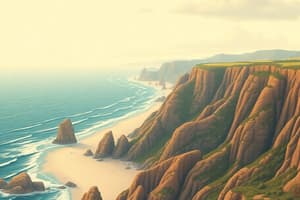Podcast
Questions and Answers
What is a coastline?
What is a coastline?
- The highest point of a mountain range
- A large, sandy desert area
- The meeting point of land and the sea or ocean (correct)
- The point where the forest meets the plains
Which of the following is a feature commonly found on a coastline?
Which of the following is a feature commonly found on a coastline?
- Rainforest
- Glacier
- Volcano
- Beach (correct)
What force shapes a cliff?
What force shapes a cliff?
- Volcanic eruption
- Earthquake
- Wind
- Sea (correct)
What is accumulation of sand shaped by the wind called?
What is accumulation of sand shaped by the wind called?
What is a 'spit'?
What is a 'spit'?
What is a tapering strip of land jutting into the sea called?
What is a tapering strip of land jutting into the sea called?
What are the rise and fall of the ocean called?
What are the rise and fall of the ocean called?
What can waves do to the land?
What can waves do to the land?
What does the way coasts are formed depend on?
What does the way coasts are formed depend on?
What term describes the particles of rock moved by waves?
What term describes the particles of rock moved by waves?
Flashcards
What is a Coastline?
What is a Coastline?
The meeting point of land and the seas or oceans, including beaches, cliffs, capes, caves, bays and estuaries.
Cliff
Cliff
A steep rock face shaped by the sea.
Skerry
Skerry
Rock tip just above the surface of the water.
Stack
Stack
Signup and view all the flashcards
Natural Arch
Natural Arch
Signup and view all the flashcards
Rocky Islet
Rocky Islet
Signup and view all the flashcards
Spit
Spit
Signup and view all the flashcards
Headland
Headland
Signup and view all the flashcards
Tombolo
Tombolo
Signup and view all the flashcards
Tides
Tides
Signup and view all the flashcards
Study Notes
- A coastline marks where land meets the seas or oceans.
- Coastlines include beaches, cliffs, capes, caves, bays, and estuaries.
- Coastal features are located close together on a coastline.
Coastal Features
- Natural Arch: An arch hollowed out of a headland by the sea.
- Beach: An accumulation of sand or pebbles along a coast.
- Cave: A natural underground cavity resulting from the dissolution and erosion of rock by water.
- Cliff: A steep rock face shaped by a sea.
- Dune: An accumulation of wind-shaped sand.
- Headland: A tapering strip of land jutting into the sea.
- Lagoon: A shallow expanse of seawater separated from the sea by a ridge of sand or a barrier island.
- River Estuary: The mouth of a river influenced by the tides, forming a coastline indentation of varying width and depth.
- Rocky Islet: A small island made of rock.
- Sand Island: An exposed summit of a sand deposit formed near or occasionally far from a shoreline.
- Skerry: A rock tip just above the water's surface.
- Spit: An elongated ridge of sand or pebbles extending into the water.
- Stack: A needle-shaped column resulting from the collapse of an arch.
- Tombolo: A ridge of sand joining an island to the shoreline.
Key Coastal Processes
- Waves, tides, and currents are the key factors in coastline formation.
- Waves erode the land when they crash onto the shore, leaving behind sediments like shells and sand.
- Coastal changes can take centuries.
- The rate of erosion depends on the material's hardness in the land and water.
- Hard rocks like granite create stable coastlines.
- Tides influence where sediment and objects are deposited on the coast.
- Large tidal ranges lead to material deposition further inland.
- High-energy waves carry more sediment.
- Coastlines with big beaches can dissipate wave energy, while small beaches concentrate it.
Coastal Issues
- Coasts are affected by pollution, oil spills, and garbage.
- Pollution negatively impacts marine life and the coastline's appearance.
Weathering Types on Cliffs
- Freeze-thaw weathering can cause cliffs to break down.
- Solution (chemical weathering) breaks down calcium carbonate (limestone) cliffs.
- Plants can contribute to cliff breakdown.
Studying That Suits You
Use AI to generate personalized quizzes and flashcards to suit your learning preferences.




